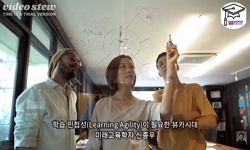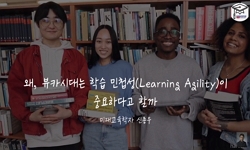The purpose of this study was to find out what kind of athletic ability is related to game proficiency when participating in DDR video game(dance dance revolution) as a leisure activity for elementary school students. For this goal, 369 elementary sch...
http://chineseinput.net/에서 pinyin(병음)방식으로 중국어를 변환할 수 있습니다.
변환된 중국어를 복사하여 사용하시면 됩니다.
- 中文 을 입력하시려면 zhongwen을 입력하시고 space를누르시면됩니다.
- 北京 을 입력하시려면 beijing을 입력하시고 space를 누르시면 됩니다.

초등학생의 비디오 댄스게임(DDR) 수행능력과 신체 운동능력과의 관계 = Relationship between Performance of Video Dance Game(DDR) and Physical Exercise Ability of Elementary School Student
한글로보기https://www.riss.kr/link?id=A103673751
- 저자
- 발행기관
- 학술지명
- 권호사항
-
발행연도
2017
-
작성언어
Korean
- 주제어
-
등재정보
KCI등재
-
자료형태
학술저널
-
수록면
19-37(19쪽)
-
KCI 피인용횟수
1
- 제공처
-
0
상세조회 -
0
다운로드
부가정보
다국어 초록 (Multilingual Abstract)
The purpose of this study was to find out what kind of athletic ability is related to game proficiency when participating in DDR video game(dance dance revolution) as a leisure activity for elementary school students. For this goal, 369 elementary school students were divided into two groups, one group was with excellent exercise performance and the other group was not. We analyzed the correlation between DDR game scores, systemic response rate to light, spatial perception ability and sub-factors of basic physical fitness. The results were as follows. First, the DDR scores of the excellent exercise group in the upper grades of male and female were higher than those of the non - excellent exercise group. Second, there was no difference in the rate of systemic reaction and spatial perception ability between excellent group and non-excellent group of male and female. Third, the DDR score was negatively correlated with the systemic response rate of the upper grades of male and female groups, which meant the better the agility of participating students, the higher the DDR score was. Fourth, the DDR score was positively correlated with the spatial perception ability of male and female senior students, which indicated the development of spatial perception ability through the DDR game. Fifth, all physical fitness factors had no correlation with DDR scores. These results indicated the possibility of evaluating the qualitative factors of subjects such as audiences' responses and cognitive spatial perception through DDR game scores. In addition, the continued involvement of DDR games as a type of leisure activity would have more positive impact on students' agility and spatial perception.
국문 초록 (Abstract)
본 연구의 목적은 초등학생을 대상으로 여가활동으로써 신체활동 참여가 가능한 비디오게임(DDR) 참여시 DDR 게임의 숙련도는 어떠한 운동능력과 관련이 있는지를 알아봄에 있다. 이를 위하...
본 연구의 목적은 초등학생을 대상으로 여가활동으로써 신체활동 참여가 가능한 비디오게임(DDR) 참여시 DDR 게임의 숙련도는 어떠한 운동능력과 관련이 있는지를 알아봄에 있다. 이를 위하여 초등학생 369명을 대상으로 운동수행능력이 우수한 학생집단과 우수하지 않은 학생집단으로 구분한 후 집단별로 DDR 게임 점수와 기초운동능력으로써 전신반응속도(빛), 공간지각능력 및 기초체력과의 상관분석을 실시하였으며, 결과는 다음과 같다. 첫째, 남녀 고학년 우수운동집단의 DDR 점수가 비우수 운동집단보다 높았다. 둘째, 전신반응속도와 공간지각능력은 남녀 학년별 우수운동집단과 비우수운동집단간 차이가 없었다. 셋째, DDR 점수는 남녀 고학년의 전신반응속도와 부적상관성이 있었으며, 참여 학생들의 민첩성이 좋을수록 DDR 점수가 높았음을 알 수 있었다. 넷째, DDR 점수는 남녀 고학년의 공간지각능력과 정적상관성이 있었으며, DDR 게임을 통해 대상자들의 공가지각능력의 발달을 기대할 수 있다. 다섯째, 모든 기초체력 하위요인은 DDR 점수와 상관성이 없었다. 이상의 결과들은 DDR 게임 점수를 통해 대상자들의 근신경적 반응 및 인지적 공간지각력과 같은 대상자의 질적요인을 평가할 수 있는 평가요인으로써의 가능성을 확인할 수 있었으며, 아울러 여가활동의 형태로 신체형 DDR 게임의 지속적인 참여는 학생들의 민첩성, 공간지각능력 발달에 긍정적 영향을 줄 수 있을 것으로 판단된다.
참고문헌 (Reference)
1 박상범, "타이밍 과제의 수행을 위한 시각적 정보이용능력의 발달과정" 8 (8): 37-48, 2000
2 최미연, "초등학생의 공간능력에서 남녀차에 관한 연구" 한국교원대학교 대학원 2004
3 張蕙旭, "시·공간능력이 운동수행 및 학습에 미치는 영향" 梨花女子大學校 大學院 1993
4 고병구, "선수 발굴을 위한 스포츠적성 진단모형 구안" 국민체육진흥공단 부설 한국스포츠개발원 14 (14): 105-121, 2003
5 고경진, "비디오 게임의 참여 동기, 충성도 및 여가활동 지속의사에 관한 연구" 한국여가레크리에이션학회 34 (34): 81-92, 2010
6 조성호, "기능성 게임을 위한 게임 효과 고찰" (사)한국컴퓨터게임학회 (16) : 17-25, 2009
7 NCTM, "principles and standards for school mathematics"
8 Rizzo, A. A., "Virtual reality and cognitive assessment and rehabilitation : The state of the art" 44 : 123-145, 1997
9 Trout, J., "Using Dance Dance Revolution in physical education" 16 : 22-25, 2005
10 Gao, Z., "The effects of curricular activity on students' situational motivation and physical activity levels" 82 : 536-544, 2011
1 박상범, "타이밍 과제의 수행을 위한 시각적 정보이용능력의 발달과정" 8 (8): 37-48, 2000
2 최미연, "초등학생의 공간능력에서 남녀차에 관한 연구" 한국교원대학교 대학원 2004
3 張蕙旭, "시·공간능력이 운동수행 및 학습에 미치는 영향" 梨花女子大學校 大學院 1993
4 고병구, "선수 발굴을 위한 스포츠적성 진단모형 구안" 국민체육진흥공단 부설 한국스포츠개발원 14 (14): 105-121, 2003
5 고경진, "비디오 게임의 참여 동기, 충성도 및 여가활동 지속의사에 관한 연구" 한국여가레크리에이션학회 34 (34): 81-92, 2010
6 조성호, "기능성 게임을 위한 게임 효과 고찰" (사)한국컴퓨터게임학회 (16) : 17-25, 2009
7 NCTM, "principles and standards for school mathematics"
8 Rizzo, A. A., "Virtual reality and cognitive assessment and rehabilitation : The state of the art" 44 : 123-145, 1997
9 Trout, J., "Using Dance Dance Revolution in physical education" 16 : 22-25, 2005
10 Gao, Z., "The effects of curricular activity on students' situational motivation and physical activity levels" 82 : 536-544, 2011
11 Anderson, M., "Reaction time measures of speed of processing : Speed of response selection increases with age but speed of stimulus categorization does not" 15 (15): 145-157, 1997
12 Jing, Feng, "Playing an Action Video Game Reduces Gender Differences in Spatial Cognition" 18 (18): 850-855, 2007
13 Graf, D. L., "Playing active video games increases energy expenditure in children" 124 (124): 534-540, 2009
14 Sallis, J., "Physical education's role in public health : Steps forward and backward over 20 years and HOPE for the future" 83 : 125-135, 2012
15 Scanlan, T. K., "Motivation in sport and exercise" Human Kinetics 119-215, 1992
16 Gao, Z., "Motivated but not active : The dilemmas of incorporating interactive dance into gym class" 9 : 794-800, 2012
17 Motl, R. W., "Measuring enjoyment of physical activity in adolescent girls" 21 : 110-117, 2001
18 Alan C. L., "Measurement and Evaluation in Physical Education and Exercise Science" Benjamin-Cummings Publishing Company 2009
19 Del Grande, J. J., "Learning and teaching geometry, K-12: 1987 yearbook" NCTM 126-135, 1987
20 Synder, C. R. R., "Individual differences in imagery and thought" University of Oregon 1977
21 Madsen, K. A., "Feasibility of a dance video game to promote weight loss among overweight children and adolescents" 161 (161): 105-107, 2007
22 Unnithan, V. B., "Evaluation of the energy cost of playing a dance simulation video game in overweight and non-overweight children and adolescents" 27 (27): 804-809, 2006
23 Lanningham-Foster, L., "Energy expenditure of sedentary screen time compared with active screen time for children" 118 (118): 1831-1835, 2006
24 Duncan, M. J., "Energy expenditure and enjoyment of exergaming : A comparison of the Nintendo Wii and the gamercize power stepper in young adults" 16 : 92-98, 2012
25 Murphy, E. C., "Effects of an exercise intervention using Dance Dance Revolution on endothelial function and other risk factors in overweight children" 4 (4): 205-214, 2009
26 유한나, "Dynavision을 이용한 정상 성인 남녀간 시각운동 반응 속도 비교" 대한작업치료학회 13 (13): 89-95, 2005
27 장철, "Dynavision을 이용한 시지각 훈련이 시지각 처리속도에 미치는 영향" 대한스포츠물리치료학회 7 (7): 17-24, 2011
28 Hayes, J., "Dance, dance, revolution and exerGaming: Just games? Or a new curriculum?" 36 : 9-16, 2011
29 Mohnsen, B., "Dance dance revolution : The next big technology device" 16 : 36-39, 2005
30 Lee, A. M., "Contributions of research on student thinking in physical education" 16 : 262-277, 1997
31 Barr-Anderson, D. J., "Characteristics associated with older adolescents who have a television in their bedrooms" 121 : 718-724, 2008
32 Gao, Z., "Associations among children's situational motivation, physical activity participation, and enjoyment in an interactive dance game" 2 : 122-128, 2013
33 Coulter, M., "An exploration of children's perceptions and enjoyment of school-based physical activity and physical education" 8 : 645-654, 2011
34 Williams, K., "Age differences on a coincident anticipation task : Influence of stereotypic or"preferred"movement speed" 17 : 389-410, 1985
35 Molina, A., "A"Fitness"revolution?" 22 : 26-27, 2004
36 Maloney, A. E., "A pilot of a video game(DDR)to promote physical activity and decrease sedentary screen time" 16 (16): 2074-2080, 2008
동일학술지(권/호) 다른 논문
-
대화지향성과 순응지향성의 가족커뮤니케이션 패턴이 여가라이프스타일에 미치는 영향: 여고생을 중심으로
- 여가문화학회
- 이은순
- 2017
- KCI등재
-
한국형 청소년 여가중독 다차원 진단 척도 개발 및 타당화 검증: 자가진단 척도를 중심으로
- 여가문화학회
- 김민규
- 2017
- KCI등재
-
신체활동 중재로써 모바일헬스케어 어플리케이션과 SMS/MMS가 신체활동량에 미치는 영향
- 여가문화학회
- 한아름
- 2017
- KCI등재
-
대도시 베이비붐세대의 여가라이프스타일이 생성감에 미치는 영향
- 여가문화학회
- 황향희
- 2017
- KCI등재
분석정보
인용정보 인용지수 설명보기
학술지 이력
| 연월일 | 이력구분 | 이력상세 | 등재구분 |
|---|---|---|---|
| 2027 | 평가예정 | 재인증평가 신청대상 (재인증) | |
| 2021-01-01 | 평가 | 등재학술지 유지 (재인증) |  |
| 2018-01-01 | 평가 | 등재학술지 선정 (계속평가) |  |
| 2017-12-01 | 평가 | 등재후보로 하락 (계속평가) |  |
| 2013-01-01 | 평가 | 등재학술지 유지 (등재유지) |  |
| 2010-01-01 | 평가 | 등재학술지 선정 (등재후보2차) |  |
| 2009-01-01 | 평가 | 등재후보 1차 PASS (등재후보1차) |  |
| 2007-01-01 | 평가 | 등재후보학술지 선정 (신규평가) |  |
학술지 인용정보
| 기준연도 | WOS-KCI 통합IF(2년) | KCIF(2년) | KCIF(3년) |
|---|---|---|---|
| 2016 | 1.25 | 1.25 | 1.19 |
| KCIF(4년) | KCIF(5년) | 중심성지수(3년) | 즉시성지수 |
| 1.37 | 1.5 | 1.307 | 0.26 |





 KCI
KCI 스콜라
스콜라






